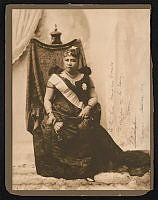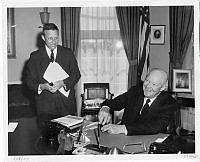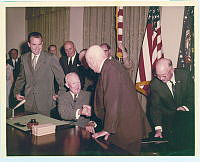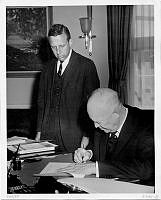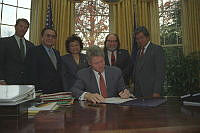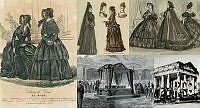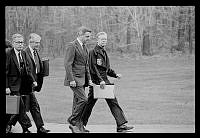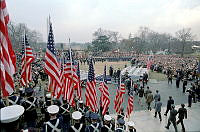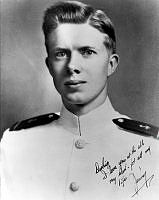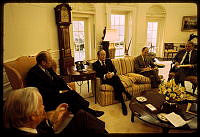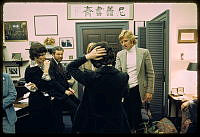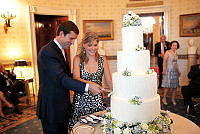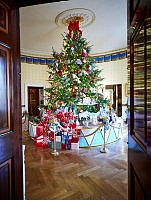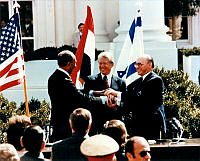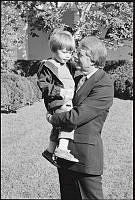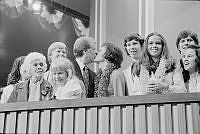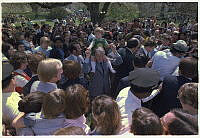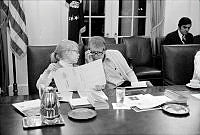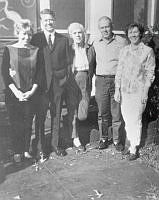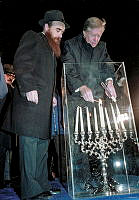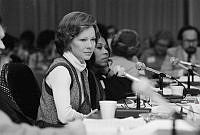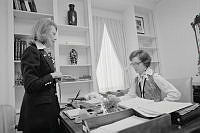Rubenstein Center Scholarship
Nellie Arthur in the White House
Nellie Arthur, daughter of President Chester Arthur, did not like the White House when she first took residence there in 1881. She found it “too big and lonesome.” In time, though, she would come to love life in the Executive Mansion.1
Ellen Herndon Arthur was born on November 21, 1871 in New York City; older brother Chester, Jr., was born in 1864. Her parents, Chester Alan Arthur and Ellen Herndon Arthur, called their daughter Nellie. Life brought a number of sudden changes for her family in a short period of time. Nellie’s mother died of pneumonia in January 1880. In November 1880 her father was elected Vice President under President James Garfield, taking office in March 1881. When President Garfield died six months later, Nellie’s father became President of the United States.
The transition to life in Washington, D.C., was difficult for Nellie. After celebrating her tenth birthday in New York City, she took a train to the capital on New Year’s Eve in order to participate in the traditional White House reception the following day. Ten days later she hosted a dinner party there for some of her friends, but her mood appeared gloomy, and a few days later she returned to New York. Word got out to the press that young Nellie Arthur was unhappy in the White House. Reporters watched to see if she would be able to adjust.
Nellie returned to the White House in April, and often had to participate in public events. Her room was near her father’s and brother’s, on the north side of the White House, “neatly fitted up, but very simple in its appointments.” Reporters watched Nellie’s every move, writing about how she looked and what she wore. One said that she had “large brown eyes and short brown hair, and that she is as chubby as a cherub.”2
Soon, however, Nellie found things to enjoy. She made a friend named Miss Botts, who was often seen playing with Nellie and a spaniel dog named Franco. She also spent a good deal of time caring for the horses in the White House stables, and learned to ride on her mother’s gentle black horse. On one occasion in the summer of 1882, reporters saw Nellie and Miss Botts rushing to the door of the White House, “quite full of childish excitement,” to see some of her father’s new horses.3
That autumn Nellie went to school in Washington, D.C., where she made new friends. Her first Christmas season was a delight, as she stayed with her father in the Soldiers’ Home several miles north of the White House while periodically returning to the Executive Mansion to take music lessons. To the public she appeared much happier and more at ease. “While last year she looked like a somewhat delicate child,” said one observer on Christmas Eve, “she now has a fresh, bright color in her cheeks and her brown eyes sparkle with childish enjoyment of the Christmas season.” On the following day she “trudged around all day with her arms full of dolls, for she . . . has a large and very interesting family of dolls, the eldest of which has a big cradle that stands by her own little bed.”4
Nellie soon had the run of the White House. As the weather improved, she and her friends were visible practically every afternoon, romping on the White House Lawn. She could come and go at public events as she pleased. In April 1883 Swedish soprano Christina Nilsson visited the White House and performed on a piano in the Green Room. While she was playing, Nellie “came tripping into the room” and the singer stopped her performance and asked the girl if she would like to request a song. Nellie said she wanted to hear “Please Give Me a Penny.” Nilsson obliged with a French ballad while Nellie “stood as if entranced.” The singer then held her arms out and asked the girl, “Don’t you think that is worth a penny?”5
Not all of Nellie’s fun took place at the Executive Mansion. In the summer of 1883, she traveled up and down the east coast from one seaside resort to another, ferried by U.S. Navy vessels. The press, noting the “merry time” she enjoyed all season and the pomp and ceremony with which she was transferred from resort to resort, took to calling her “Princess Nellie.”6

President Chester Arthur reads to his daughter Nellie in the White House. From an 1885 issue of Leslie’s Illustrated Newspaper.
Library of CongressAlthough she enjoyed the privileges of being the president’s daughter, Nellie carried a strong sense of responsibility for the less fortunate. In the autumn of 1883 she formed a Christmas Club, with seventy-five children as members and herself as president. Each member contributed funding to erect a huge Christmas tree hung with expensive ornaments that would be unveiled at a charity ball for underprivileged children in Washington, D.C. Nellie managed the club quite efficiently. “Miss Arthur makes a model little president,” commented one newspaper; “filling the chair with dignity and rare good judgment, and signing her name, Ellen H. Arthur, with as much dignity as her paternal scrawls his signature to official documents at the great White House.”7
The Christmas Club soon became a major operation, even larger than Nellie had intended. On December 28, 1883 the club hosted events at four different locations in Washington, D.C., providing entertainment for over 2,000 ill and homeless children. The president attended the event at the National Rifles Armory, but Nellie, wearing a white lace sash, was the star of the show: singing with a girls’ choir, waiting on tables, and distributing gifts—including the tree ornaments. “Her unaffected manners and interest in all that was being done illustrated the spirit which animated the entire club,” reported the Washington, D.C., Evening Star.8
Once too big, the White House soon became too small for Nellie. To provide more room for play, she built a small house under the East Entrance. Made of unpainted ash boards, covered with myrtle and ivy and resembling a “fairy arbor,” it became known as “the headquarters of Miss Nellie Arthur and her dolls.” The house had two doors and four windows with muslin curtains held back with ribbons, a bureau, a sofa, a writing desk, a bed, pictures, a Turkish rug, and of course mounds of dolls and toys. A small ebony table stood in the corner, where Nellie and her friends gathered for “doll gossip” and “weak tea.” Although the girls got along well in the house, Nellie acted as the final arbiter for all questions of social precedent, with no right of appeal. The president himself liked to watch the children from the window of his White House office, but he could not visit for he was too large to fit through the door.9
Nellie also had a couple of four-footed companions. One was a Skye Terrier named Toddie. The dog obeyed only Nellie and defied everyone else, even the president. When President Arthur tried to pet Toddie, the pooch bit him. Another pampered pet was a calico Indian pony that an Arapahoe Indian chief gave to the president in the summer of 1883, and which he gave to Nellie. She trained the “cute little thing” to pull her in a dog cart.10
By 1884, her last full year in the White House, Nellie had become a pro at attending public events. In June of that year she ascended the nearly-finished Washington Monument and placed a stone at its top. Her “clear, silvery voice” and “merry laughter” had become a White House fixture, and she was a favorite of the staff—not least because Nellie did not appear spoiled and treated everyone with politeness and respect.11

President Chester A. Arthur.
White House Historical Association/White House CollectionOne day, Nellie was out riding with her father when their carriage nearly hit a handicapped African-American girl, who was not injured but badly frightened. President Arthur made amends with a $5 bill, but Nellie leapt out of the carriage and stayed with the girl for some time. The following day, Nellie sent the child a bouquet and a bundle of toys. Afterwards she stopped by to visit the girl’s home on occasion, without any publicity, and continued to send her toys even after her father was no longer president.12
Nellie Arthur celebrated her thirteenth birthday with six friends at the Soldiers’ Home on November 21, 1884, and again presided over the Christmas Club in December. By then her father had decided not to run for another term as president. The Baltimore Sun lamented that she would “have to leave the White House just at an age when she would be most likely to enjoy and appreciate her situation, and having been a rather more sensible child than the average girl would be in her position, her school friends are sorry to lose her.”13
On President Arthur’s final day in the White House, March 4, 1885, Nellie departed with Toddie in her arms. Pausing in the North Portico, she turned to the assembled staff and, holding the dog over her head, said “Say good-by to everybody, Toddie.” The dog gave several barks by way of farewell, and then Nellie Arthur sprang into the waiting carriage. The staff, and the public, mourned her departure from the White House as “one vacancy that cannot be filled.”14
The adventures did not end for Nellie, or for Toddie. Back in New York City, Toddie had a run-in with a dog catcher who consigned him to two hours’ confinement with “the lowest class of dogs” until a servant redeemed him with a $3 fee. Nellie returned to Washington, D.C. for many years to preside over the Christmas Club and visit the White House. She left her doll house at the White House, where it stayed until at least 1896 near the East Entrance but without any occupants. When last mentioned in 1900, it was stored in the White House basement. Nellie graduated from Williams College and became engaged to Charles Pinkerton while climbing Pike’s Peak, near which the couple honeymooned after marrying in 1903. She died in Mount Kisco, N.Y., in 1915.15













